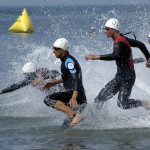-
Wetsuit design – what will make me go faster?
- Posted onjofrancis
- in Accessories, Website Articles
- onJuly 3, 2014
- No Comments.
 I am often asked by my athletes for advice on which brand of wetsuit will be right for them. My stock answer is that they should go to a show or a shop that has several makes and try on a few to see which suit provides the best fit for them. While this remains true, in the last few years there has been an explosion of new wetsuit providers bringing innovation to the market. Where once it was just about fit (yes it is several years since I bought my last wetsuit) now there are many more aspects to consider. Here are three things worth thinking about.
I am often asked by my athletes for advice on which brand of wetsuit will be right for them. My stock answer is that they should go to a show or a shop that has several makes and try on a few to see which suit provides the best fit for them. While this remains true, in the last few years there has been an explosion of new wetsuit providers bringing innovation to the market. Where once it was just about fit (yes it is several years since I bought my last wetsuit) now there are many more aspects to consider. Here are three things worth thinking about.Variations in thickness of neoprene: In the dark old days, wetsuits were of one thickness in neoprene all over – yes really – ha ha. That is why athletes were so often complaining that their arms got tired when swimming in their wetsuit. No such excuse now folks. Most brands have variations in thickness across the suit, ensuring super flexibility around the shoulders which is a must-have when considering your options. Since many triathletes are “developing” swimmers wetsuit manufacturers are now offering 5 mm thickness around the lower body while using 1.5 – 3 mm across the upper body. This variation will have a big impact on your hip and leg positions and this will certainly translate into better performance. Note here – this is not a get out of jail free card – sinking legs are often a result of a lack of stretch and streamlining at the front of your stroke as well as a disruptive kick – continue to work on your technique (see our Stroke Builder Swim App for help with your stroke development) so that the wetsuit is not a “crutch”.
Catch panels: There seems to be a difference of opinion between manufacturers as to whether catch panels are actually beneficial or not and it is also worth noting that different forms of arm panels are meant to convey a different sort of performance benefit.
Many suits now have ridged (in a very precise way of course) arm panels that are meant to improve our catch/pull phases. One manufacturer claims that their panels increase the cross section area of the arm by 8%. On the other hand Huub Toussaint, the scientist behind the Huub range says that they probably don’t work (interview at http://buccaneertri.com/huub-toussaint/) which is why you don’t see catch panels on the Huub wetsuits. It is not a simple matter to find the underlying research to validate or otherwise the use of catch panels but in many independent reviews the reviewer finds no discernable performance benefit from these panels. In the last couple of years there have also been some ground breaking arm panel designs that have been subsequently banned (an early version of the Speedo Tri Elite). So if extreme benefits are suggested by the manufacturer, it is also worth asking “okay but is it legal!?”
Other manufacturers modify their arm panels not for increased surface area but to allow for a closer “feel” of the water (Zone 3 Vanquish, Mako eXtreme) which may appeal to a technically advanced swimmer.
Zippers: No excuse for sloppy transitions either – now we have a choice of standard, reverse or breakaway zips.
The Standard zip is a regular zip. The bottom stop of the zipper is sewn in to the wetsuit so you just need to pull up to close the zipper or pull down to open in transition. The perceived advantage is that they are generally easier to put on if you are on your own. Next innovation was the Reverse zip with the zipper running from top to bottom. This is generally thought to be more difficult to put on on your own although there are plenty of videos on line showing you how easy it is with practice. It is meant to be a little bit quicker to release because you are pulling up rather than down. And finally another innovation, first seen on Quintana Roo wetsuits, and that is the Breakaway zipper.
What is a Breakaway zipper I hear you ask? Basically, this zipper comes apart all at once (with a hefty tug) rather than from the top or bottom.
These are all selling points designed to give you the edge – although as was pointed out on one forum, unless you are positioned in transition immediately by swim exit, you should have sufficient time to undo any sort of wetsuit by the time you get to your bike.
So, the advice remains; get a good fit, look for flexible shoulders and practice getting in and out of the suit!
If you enjoyed this article please consider sharing it!




